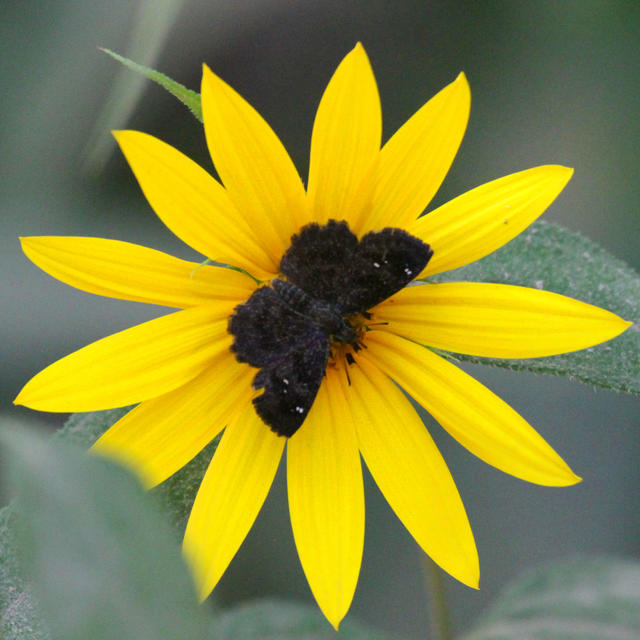Hayhurst's Scallopwing
Staphylus hayhurstii (W.H. Edwards, 1870)
Family: Hesperiidae
Subfamily: Pyrginae
Identification: Wing margins are scalloped; fringe is checkered black and tan. Upperside is dark brown with 2 darker bands across each wing; forewing has a few tiny translucent dots.
Wing Span: 1 - 1 1/4 inches (2.5 - 3.2 cm).
Life History: Adults rest on leaves with the wings held open, and hide in bushes when disturbed. To find females, males perch on low vegetation in partial sun along forest edges. Females lay eggs singly under host plant leaves. Caterpillars rest in rolled leaves during the day and eat leaves at night. Third-stage caterpillars hibernate in tightly-silked dead leaf shelters.
Flight: Two broods; from May-August in most of its range, April-September in Mississippi, February-December in Florida.
Caterpillar Hosts: Lambsquarters (Chenopodium) in the goosefoot family (Chenopodiaceae), and occasionally chaff flower (Alternanthera) in the pigweed family (Amaranthaceae).
Adult Food: Nectar from marigold, knotweed, spearmint, wild marjoram, cucumber, dogbane, white sweet clover, and white clover.
Habitat: Roads, trails, and openings in woods; vacant weedy lots; suburban gardens.
Range: Eastern Nebraska east across the southern Midwest to southern Pennsylvania; south to Florida, the Gulf states, and central Texas.
Conservation: Not usually required.
NCGR: G5 - Demonstrably secure globally, though it may be quite rare in parts of its range, especially at the periphery.
Management Needs: None reported.
Comments: NULL
BAMONA Shop
Please donate!
We depend on donations to keep Butterflies and Moths of North America freely available. We want to express our gratitude to all who showed their support by making a contribution this year. You can donate to support this project at any time.
Advertise with us!
Do you have a product or service that you think would interest BAMONA users? If you would like to advertise on this website, contact us by email, or use the contact form and select the "Advertising" category.
Verified Sightings
Displaying 1 - 24 of 788 verified sightings

Observation date: Apr 29, 2025
Submitted by: Sheilabean
Region: Texas, Tarrant County, United States
Verified by: jwileyrains
Verified date: May 01, 2025

Observation date: Feb 03, 2023
Submitted by: dvollmar
Region: Hendry County, Florida, United States
Verified by: John Calhoun
Verified date: Sep 15, 2024

Observation date: Jun 17, 1996
Submitted by: papilio1
Region: Collin County, Texas, United States
Verified by: jwileyrains
Verified date: Sep 03, 2024

Observation date: Jul 29, 2024
Submitted by: jehartg
Region: East Baton Rouge Parish, Louisiana, United States
Verified by: CA Ivy
Verified date: Aug 02, 2024

Observation date: Jul 28, 2024
Submitted by: jehartg
Region: East Baton Rouge Parish, Louisiana, United States
Verified by: CA Ivy
Verified date: Aug 02, 2024

Observation date: Jul 23, 2024
Submitted by: jehartg
Region: East Baton Rouge Parish, Louisiana, United States
Verified by: CA Ivy
Verified date: Aug 02, 2024

Observation date: Jul 25, 2024
Submitted by: jehartg
Region: East Baton Rouge Parish, Louisiana, United States
Verified by: CA Ivy
Verified date: Jul 25, 2024

Observation date: Jul 23, 2024
Submitted by: Sheilabean
Region: Texas, Tarrant County, United States
Verified by: jwileyrains
Verified date: Jul 25, 2024

Observation date: Jul 21, 2024
Submitted by: Sheilabean
Region: Texas, Tarrant County, United States
Verified by: jwileyrains
Verified date: Jul 22, 2024

Observation date: Jul 21, 2024
Submitted by: Sheilabean
Region: Texas, Tarrant County, United States
Verified by: jwileyrains
Verified date: Jul 22, 2024

Observation date: Jul 12, 2024
Submitted by: theskyeworld
Region: Bastrop County, Texas, United States
Verified by: jwileyrains
Verified date: Jul 12, 2024

Observation date: May 30, 2024
Submitted by: scream of the b...
Region: Shelby County, Tennessee, United States
Verified by: James Steen
Verified date: May 30, 2024

Observation date: Mar 20, 2024
Submitted by: jehartg
Region: East Baton Rouge Parish, Louisiana, United States
Verified by: CA Ivy
Verified date: Apr 15, 2024

Observation date: Jun 16, 2023
Submitted by: dchartier
Region: Prowers County, Colorado, United States
Verified by: mikefisher
Verified date: Jul 23, 2023

Observation date: Jul 08, 2023
Submitted by: bekkfree
Region: Cowley County, Kansas, United States
Verified by: James Steen
Verified date: Jul 08, 2023

Observation date: May 24, 2023
Submitted by: Tdloyd
Region: Sumner County, Tennessee, United States
Verified by: James Steen
Verified date: May 25, 2023

Observation date: Oct 15, 2021
Submitted by: Beth Polvino
Region: Cape May County, New Jersey, United States
Verified by: curtis.lehman
Verified date: May 20, 2023

Observation date: Oct 07, 2021
Submitted by: Beth Polvino
Region: Cape May County, New Jersey, United States
Verified by: curtis.lehman
Verified date: May 20, 2023

Observation date: Jun 20, 2022
Submitted by: Christian.Nunes
Region: Prowers County, Colorado, United States
Verified by: mikefisher
Verified date: Feb 15, 2023

Observation date: Sep 05, 2021
Submitted by: Brynne Bryan
Region: Denton County, Texas, United States
Verified by: jwileyrains
Verified date: Jan 18, 2023

Observation date: Jul 07, 2022
Submitted by: WYbutterflyer1
Region: Montgomery County, Arkansas, United States
Verified by: CA Ivy
Verified date: Oct 15, 2022

Observation date: Jul 04, 2021
Submitted by: KatGrahamBlue
Region: Bastrop County, Texas, United States
Verified by: jwileyrains
Verified date: Oct 09, 2022

Observation date: Aug 01, 2021
Submitted by: Christinalea
Region: Texas, Wichita County, United States
Verified by: jwileyrains
Verified date: Oct 09, 2022

Observation date: Aug 06, 2021
Submitted by: Thomlinson
Region: Denton County, Texas, United States
Verified by: jwileyrains
Verified date: Oct 08, 2022
- 1 of 33
- next ›










